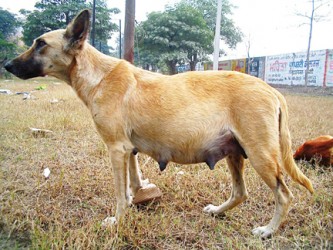(continued)
Over the last few weeks, we departed from our theme of “Infertility” and dealt with the topic of “Spaying and Neutering” as a method of stopping fertility (pregnancy).
Let us today return to the topic of “Infertility”.
False Pregnancy
Technically, this topic should not be placed under the heading of ‘Infertility’, but I really don’t know where else to put it. Besides, we are dealing with an imbalance in the animal’s hormone system which in fact can lead to ailments of the womb (uterus) and ovaries, and finally to infertility.

Occasionally, the false-pregnant bitch appears to exhibit severe uterine cramps. As mentioned above, caking of the breast is not unusual, but it is another source of discomfort.
I really should mention here that this false pregnancy situation is not always immediately clear to you and sometimes not definitely obvious to your veterinarian. So, the final and definitive diagnosis might have to be made after several visits to your vet who will in due course eliminate the possibility of a true pregnancy after compiling the history of the animal’s behaviour and the other symptoms delineated above. He/she will, at every visit, palpate the abdomen, and eventually, if necessary, recommend that you get an x-ray done or even an ultrasound.
Treatment

For caked breasts, you may massage them with camphorated oil; apply hot packs; squeeze the breast so as to express the coagulated milk.
Enough for today; you have got only a few days to prepare for Phagwah and Easter.
Please implement disease preventative measures (vaccinations, routine dewormings, monthly anti-Heartworm medication, etc) and adopt-a-pet from the GSPCA’s Animal Clinic and Shelter at Robb Street and Orange Walk, if you have the wherewithal to care well for the animals. Do not stray your unwanted pets, take them to the GSPCA’s Clinic and Shelter instead. If you do not wish your pet to have puppies or kittens, you may exploit the GSPCA’s free spay and neutering programme. If you see anyone being cruel to an animal, or if you need any technical information, please get in touch with the Clinic and Shelter by calling 226-4237.






